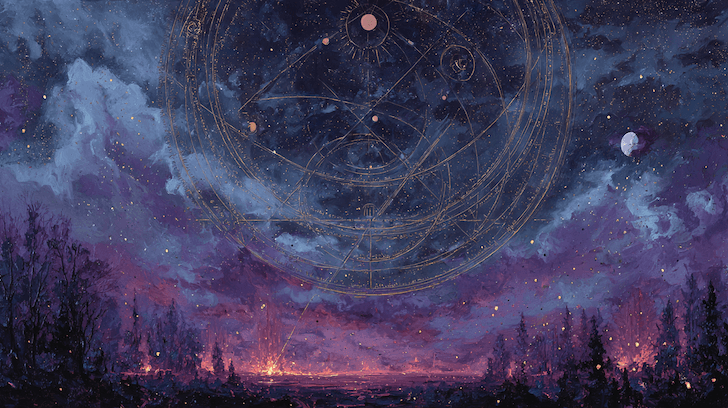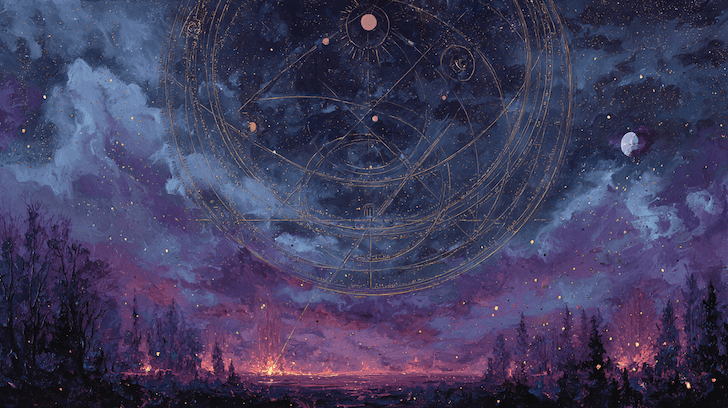What Are Orbs in Astrology?

An orb measures how close two planets (or points) are to forming a perfect aspect—the exact angle that links their energies.
When astrologers say “a 3° orb,” they mean the planets are 3 degrees away from being exactly conjunct, opposite, square, trine, sextile, or another geometric relationship.
An orb doesn’t create the aspect—it describes the tolerance around it. Think of it like a magnet: the closer the planets get to exact, the stronger the pull.
Orbs show closeness to exactness. The tighter the orb, the stronger and clearer the expression. The wider the orb, the more subtle or background the influence.
Why Orbs Matter
Every aspect is defined by geometry—a conjunction (0°), square (90°), trine (120°), opposition (180°), and so on.
But orbs decide how strongly that geometry operates. A square that’s exact is vivid and dynamic; one that’s 6° apart might still matter but fades in intensity.
Orbs help astrologers distinguish between main themes (tight or exact aspects) and background patterns (wider or looser ones). They also help keep readings clear by ranking aspects by impact.
- Exact aspects (0–1°) are the loudest—they define behavior and timing.
- Moderate orbs (2–4°) stay active but less dominant.
- Wide orbs (5–8°) describe mood or potential, more noticeable when repeated elsewhere.
Why Some Aspects Allow Bigger Orbs
Not all aspects are created equal—some are more visible in experience.
Major aspects like conjunctions, oppositions, and squares represent stronger angular relationships and usually deserve larger orbs, while minor aspects like sextiles or quincunxes use tighter ranges.
Orbs also depend on which planets are involved. The Sun and Moon—being visually dominant—allow broader orbs. Slower or dimmer planets (like Neptune or Pluto) have smaller, subtler spheres of influence.
Typical Orb Ranges (Natal Charts)
| Aspect | Standard Orb | Notes |
|---|---|---|
| Conjunction (0°) | up to 8° | Acts like a merger—use wider orbs for Sun/Moon, narrower for outers. |
| Opposition (180°) | up to 7° | Polarity; strongest when both planets are angular or luminaries. |
| Square (90°) | up to 6° | Dynamic tension; 3–4° reads clearest for outer planets. |
| Trine (120°) | up to 6° | Ease and flow; can go wider if repeating the same element. |
| Sextile (60°) | up to 4° | Opportunity aspect—keep it tight for precision. |
| Quincunx / Inconjunct (150°) | up to 3° | Adjustment; small but noticeable when exact. |
| Semisextile (30°) | up to 2° | Very subtle—habit-level or background tone. |
Orbs in Transits
Orbs apply differently when a moving planet (transit) connects with a natal planet. A transit’s effect begins when it enters orb and peaks at exactness—then fades as it separates.
- Faster transits (Moon, Mercury, Venus, Sun): 1–3° orb—events move quickly and fade fast.
- Moderate transits (Mars, Jupiter): 2–4° orb—effects last days to weeks.
- Slow transits (Saturn → Pluto): 3–6° orb—effects unfold over months or years.
| Planet | Typical Orb for Transits | Duration |
|---|---|---|
| Moon | 1–2° | Hours to 1 day |
| Mercury | 1–2° | 1–3 days |
| Venus | 1–3° | 2–4 days |
| Sun | 2–3° | 2–5 days |
| Mars | 2–4° | 1–2 weeks |
| Jupiter | 3–5° | 2–3 months |
| Saturn | 3–5° | 3–6 months (stationary longer) |
| Uranus | 3–4° | 6–18 months depending on speed |
| Neptune | 2–3° | 1–2 years, slow to manifest |
| Pluto | 2–3° | 2+ years, felt psychologically before exact |
Applying vs. Separating Orbs
An applying aspect means the faster planet is moving toward exactness—energy is building. A separating aspect means the aspect has just perfected and is fading.
In natal charts, applying aspects show tendencies still forming; separating aspects show skills already lived.
In transits, applying orbs often trigger events, while separating orbs mark integration or resolution.
How to Use Orbs in Practice
- Start wide (up to 8°) when scanning the chart, then narrow to 3° or less for precision.
- Prioritize exact aspects between luminaries and angles.
- When reading transits, note when an aspect enters orb, perfects, and leaves—these mark the story’s beginning, climax, and conclusion.
- If the same pattern repeats (e.g., natal square + transit activation), it amplifies—use tighter orbs for cross-checking.
Quick Reference: Orbs by Planet Type
| Planet Type | Recommended Natal Orb | Recommended Transit Orb |
|---|---|---|
| Sun / Moon (Luminaries) | 6–10° | 3–5° |
| Mercury / Venus | 5–7° | 2–3° |
| Mars / Jupiter | 4–6° | 2–4° |
| Saturn / Uranus / Neptune / Pluto | 3–5° | 2–3° |
| Angles (ASC / MC / IC / DSC) | Up to 8° | Up to 4° |
Putting It All Together
An orb simply measures closeness to exactness—how tightly two planets align. Wider orbs describe background energy; tighter orbs signal core patterns or events. In natal charts, orbs show intensity; in transits, they show timing.
Understanding orbs helps you read when energy is strongest, and how precisely two planets are speaking.
When you grasp orbs, you stop guessing if something matters—you can see exactly how much it does.
What Are Aspects in Astrology?

How to Read Transits

Get Your Birth Chart
Calculate your complete astrological chart with precise astronomical data based on your birth time and location
Generate Chart